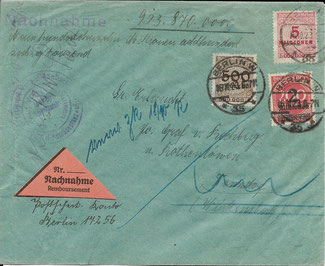Hyperinflation
In 1922, war debts and reparation demands led to increasing inflation. The occupation of the Ruhr by the French and Belgians and German resistance to it through strikes financed by the state finally led to massive monetary devaluation, which peaked in November 1923.
Postal rate changes 1921-1923 during the (hyper)inflation period (log10 scale)
500.000: Obsolete as single franking upon issue
2 million: Scarcely used due to abundance of overprinted stamps
30 million: Scarcely used since only for foreign postal rate
50 billion: Very rare since no single franking and high value (200 billion) in 4-times period
In this hyperinflation, which accelerated sharply in the autumn months of 1923, there was a currency reform on November 15, 1923, whereby the new Rentenmark was exchanged for the inflationary paper mark at the rate of 1 Rentenmark = 1 trillion paper marks. In 1924, the Reichsmark then replaced the Rentenmark at a ratio of 1:1. Postal rates also accelerated dramatically between 1922 and 1923. The new Rentenmark did not make itself felt in postal rates until December 1, 1923, because the Rentenmark was only slowly becoming available.
On November 30,, the last inflation rate for a letter up to 20g was 80 billion (paper) marks. On December 1, due to the currency conversion in the postal tariff, the postage was then 10 Rentenpfennig. The inflation stamps could still be used up in December 1923, although only the high inflation face value stamps could be used meaningfully. From December 1, 1923, the imprinted nominals were valid again for the inflation stamps. Covers from December 1923 with inflation stamps are called "December letters", covers from the last inflation fee period are called "November letters".
Overprint Numerals in circles (20.000 to 250.000)
Due to the increasingly rapid succession of changes in postal rates, many stamps could only be used for a short time at their actual face value, or only when used up. Therefore, original stamps were overprinted with new values to meet the increasing postal rates without having to constantly print new stamps. Because of the galloping inflation, corresponding stamps are much more common mint than used, since the periods of meaningful use were sometimes very short.
Overprint Numerals in circles (250.000 to 800.000)
The practice of overprinting was started on August 24, 1923. The last overprints were issued on November 23, 1923. Due to the massive inflation during this period, various original stamp series (numerals in rectangles, workers, numerals in circles, and basket lid designs) were overprinted. Overprints during this period ranged from 5000 to 10 billion marks.
From October 8, 1923 to November 24, 1923, a new series of stamps was issued in the rosette/basket lid pattern (without overprint). But this too was affected by hyperinflation. The nominal values ranged from 500.000 to 50 billion marks. In this stamp series, some of the stamps are either very rarely used, or could no longer be used as single franking, as intended, because the face value was already "obsolete" when issued.
Overprint Numerals in circles (800.000 to 2 million)
On December 1, 1923, in the course of the currency reform, a set of stamps with 3 to 100 Rentenpfennig was issued, also in the rosette/basket pattern design.
Rosette-/basket lid pattern (1 million to 20 billion)

Cash on delivery (COD) for the value of 923.870.000 Marks from Berlin W35 to Donzdorf dated October 16, 1923 (postage period 20). Correct postage with 7.5 million Marks franking (5 million letter up to 20 grams + 2.5 million for COD). One 500.000 stamp. Acceptance probably refused, as handwritten “retour” dated October 18, 1923.

Postcard from Landsberg to Braunsberg dated October 15, 1923 (postage period 20). Correct franking of 2 million marks
Letter (up to 20 gram) from Scheidegg to Lauben dated November 16, 1923 (postage period 24). Correct postage with bulk franking with 20 x 500 million = 10 billion Marks. Stamps affixed on the reverse.
Withdrawn, controversial and exceptional stamps and other withdrawn postally issued items
| * | = | Withdrawn |
|---|---|---|
| ** | = | Controversial |
| *** | = | Exceptional |
| **** | = | Unclear |
Diese Webseite wurde mit Jimdo erstellt! Jetzt kostenlos registrieren auf https://de.jimdo.com















